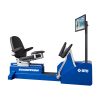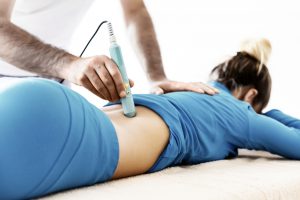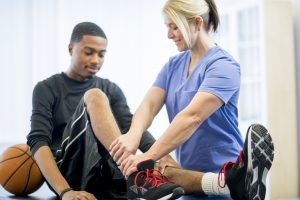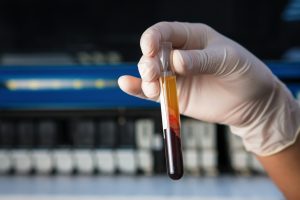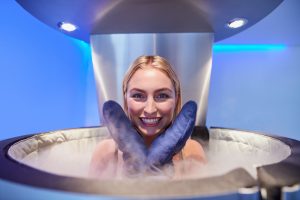
Chill Out With Cryotherapy
Treatment GuidelinesA cryosauna is a temperature-controlled enclosure with an open top. Picture a shoulder-high telephone booth without a roof. Before stepping inside, you usually put on special socks and gloves to prevent your feet and hands from getting too cold.
Perhaps one of the most common treatments in outpatient rehab or sports medicine is cryotherapy, or cold therapy. You would be hard-pressed to find a clinic without an ice machine and bags handy. Athletes in particular seem to be hardwired to reach for ice bags or a cold bath following a workout.
With almost every rehab and training professional using ice, it’s no wonder that technology has evolved to bring a new – and potentially better – way to do cryotherapy.
Simply stated, cryotherapy is cold treatment used to achieve a desired effect. For some, that may be relieving muscle soreness. Some even believe that it helps to prevent delayed onset soreness altogether. Others use it in immediate response to injury. Whatever the reason, ice and cold are frequently the go-to remedy for injury and soreness.
Traditional Ice Bag
Ice bags are the most common form of cryotherapy. In sports medicine, large ice machines produce hundreds of pounds of ice at a time. Some prefer the large cubed ice while others choose the smaller snowflake ice, believing it to provide better coverage.
Digging into this concept, one study compared three types of ice to determine which provides the most effective cooling.1 Comparing wetted ice, crushed ice, and cubed ice, researchers found that each provided significant cooling. The most effective type of ice was the wetted ice, as it resulted in the greatest temperature change of 10.8°F (6°C) within the muscle, and 30.6°F (17°C) on the surface.1
It is important to note that these measurements were taken directly under the administered ice and it is likely that no cooling took place more than a few inches away from the treated area.Ice bags are a great way to provide localized benefits of cold therapy. But for full body benefit, you’ll need a different approach, like ice baths.
Ice Bath
From high school to professional leagues, most sports medicine programs have some form of cold tub available for full extremity or full body immersion. Full immersion tubs provide the therapeutic benefits of ice immersion as well as rapid cooling that’s sometimes needed in athletic environments.
One of the greatest benefits of ice immersion is vasoconstriction. The cold creates a contraction around and within the blood vessels. This contraction acts as a pump that moves fluids through the lymphatic system.
One of the better-known benefits of cold immersion is the decreased rate of delayed onset muscle soreness. Immersion in cold baths following moderate to intense workouts has led to a decrease in post workout pain at every 24-hour interval for four days.2
Most baths are a stainless-steel tub with an electric motor that provides either hot or cold temperatures. The practitioner chooses the temperature based on the athlete’s or patient’s need. Though common and heavily used, this modality can be difficult to administer to multiple individuals at a time.
In modern sports medicine facilities, you are likely to find large rooms that are wholly dedicated to hydrotherapy. Complete hydrotherapy rooms usually have hot tub, a cold tub, and possibly underwater treadmills. These rooms allow for multiple therapeutic interventions to occur at a time with multiple individuals.
Contrast Bath
Some facilities have the advantage of both a hot and cold bath positioned in close proximity. Used together, this hydrotherapy method is called a contrast bath. The individual will switch back and forth between the hot and cold baths. Contrast baths are said to reduce pain, soft tissue swelling and inflammation, and decrease joint stiffness and muscle spasms.3
The principle behind it posits that switching between cold and hot temperatures causes vasoconstriction and vasodilation, which creates a pumping effect throughout the lymphatic system.
Typically, the two bath temperatures are 46°F (8°C) and 104°F (40°C).4 Many athletes use contrast baths in their pre- and post-workout and practice routine. Some even consider it an essential part of recovery.
Cryosaunas
In the past few years, a new form of cold therapy has gained popularity. Cryochambers and cryosaunas are now a valued component of athletic recovery, and a growing trend in wellness.
Facilities around the world promote cryochambers as a more effective and time-efficient way of achieving benefits beyond traditional cryotherapy. You can find them in collegiate and professional sports medicine facilities, some rehab clinics, and in the homes of professional athletes and even some non-athletes. You can also find wellness boutiques that make them available to the public with a per-use or monthly payment.
A cryosauna is a temperature-controlled enclosure with an open top. Picture a shoulder-high telephone booth without a roof. Before stepping inside, you usually put on special socks and gloves to prevent your feet and hands from getting too cold. Once inside, you remain standing with your head above the walls. It works by pumping in liquid nitrogen that rapidly decreases the air temperature inside.
Watch a crysauna demonstration:
Cryochambers
In contrast, a cryochamber is more like a walk-in freezer. Instead of your head remaining exposed, your whole body is enclosed inside the cryochamber. This enclosure allows for a full-body chill.
During a cryo session, the air temperature drops to about -238°F (-150°C). As a result of the chilled air, skin temperature will decrease to 30-50°F (-1 – 10°C). A typical session will last for no more than about two to three minutes and is safe for most healthy individuals.
Cryotherapy Research, Benefits, and Safety
One review looked at the existing literature to determine whether whole-body cryotherapy can improve athletic performance. This review was overwhelmingly positive for the effectiveness of cryochambers in reducing inflammatory conditions present in athletic individuals5.
Those who performed whole-body cryotherapy have reported less soreness. This is the result of the cold therapy creating peripheral vasoconstriction, decreased submaximal heart rate, and stimulated nervous system activity.
In terms of safety, certain contraindications exclude certain patients from cryotherapy. For example, those with cold intolerance, Reynauds, unstable angina, blood flow disorders, and cardiovascular disease should certainly apply caution to using cryotherapy chambers. However, the research shows that full-body cryotherapy is beneficial, and that this type of treatment is inherently safe.
Conclusion
Many people may be fearful to allow their body to get too cold, even if there are positive side effects. There are certainly contraindications you should review before recommending it to those you treat. But overall, the research is encouraging. If you’re curious about cryosaunas or cryochambers, consider visiting a facility near you to try it for yourself. It never hurts to take the time to “chill out”!
Jeffrey Johnson, MA, ATC
Clinical Specialist
BTE
References
- Dykstra J, Hill H, Miller M, Cheatham C, Michael T, Baker R. Comparisons of Cubed Ice, Crushed Ice, and Wetted Ice on Intramuscular and Surface Temperature Changes. Journal of Athletic Training. 2009; 44(2): 136-141.
- Aguilera E, Ibacache P. Cold-water immersion versus passive therapy to decrease delayed onset muscular soreness. Medwave. 2014; June 12;14 (5).
- Versey NG, Halson SL, Dawson BT. Water immersion recovery for athletes: effect on exercise performance and practical recommendations. Sports Med. 2013;43(11):1101–1130.
- Babak Shadgan, Amir Pakravan, Alison Hoens, Darlene Reid. Contrast Baths, Intramuscular Hemodynamics, and Oxygenation as Monitored by Near-Infrared Spectroscopy. Journal of Athletic Training. 2018;53(8): 782-787.
- Lombardi G, Ziemann E, Banfi G. Whole-Body Cryotherapy in Athletes: From Therapy to Stimulation. An Updated Review of the Literature. Frontiers in Physiology. 2017; 8: 258. 1-16.

